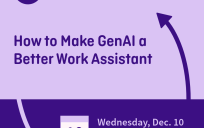In school, we all had classes where the teachers would stand at the front of the room and lecture on material for an hour. And we all had classes where we wanted to fall asleep. Luckily there is a new, different approach to this traditional learning tactic: it’s flipping the classroom upside down.
The premise of the flipped classroom approach is that participants complete live online trainings on their own time and then come together to discuss and solidify what they learned. As a result, participant engagement grows.
The flipped classroom approach hinges on these four activities:
- Focus on the participant: The flipped model takes focus off of the instructor and puts it on the participant. It is catered around the schedule of course participants giving them flexibility that’s not possible with classroom settings. It then repurposes class time into workshops where students can inquire about lecture content, test skills, and interact with others in discussion activities. The length of these courses depends on subject material. Courses can have a variety of different modules lasting a month’s duration – or can easily be wrapped up within a week’s time.
- Engaging video content: Gone are hour-long lectures with drowsy students struggling to pay attention. The flipped classroom breaks content down into short videos or vignettes that are easily digestible. Class instructors or subject matter experts create these informative, engaging videos. Usually, videos are no longer than 15 minutes, allowing participants the ability to watch content in between meetings or during lunch.
- Performance evaluations: Evaluations are not ignored in the flipped model. Quizzes could appear at the end of short videos, or after completing a course module. And while they can test participants on course knowledge, their function is to measure retention rates and content alignment to course objectives.
- Group discussions: Discussions are an integral part of what makes the flipped classroom work so well. After viewing and digesting content on their own time, participants come together to discuss what they learned, either on online platforms or in-person sessions. Discussions enable peer-to-peer learning and allow participants the opportunity to hear from previously identified seasoned professionals who are seeking to share their knowledge.
So what does a flipped classroom actually look like in practice? The GovLoop learning team is a big advocate of the flipped approach and often utilizes it on client courses. Here’s a breakdown of the different flipped learning activities the team uses.
- Recorded Learning Vignettes: Introduce key concepts.
- Asynchronous Discussions: Hold discussions with other learners and share knowledge among each other.
- Structured Group Activity: Course participants apply concepts to specific training activities reflective of real work objectives.
- 60 Minute Live Webinars: Designed to reinforce key concepts and provide opportunities for participants to ask questions and share best practices.
- Quizzes: Measure knowledge retention and content alignment objectives.
So is the flipped classroom model successful? For a course the GovLoop learning team made for the Federal Highway Administration, 82% of participants said that there was enough interaction to stay engaged throughout the course’s duration. Now, you be the judge.





Very interested in all this new new teaching approaches.